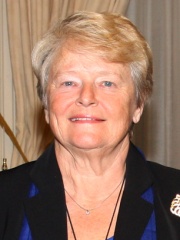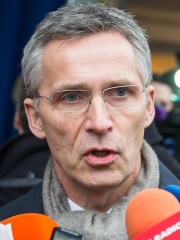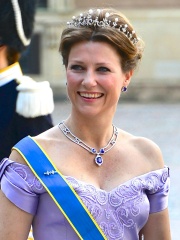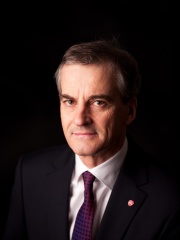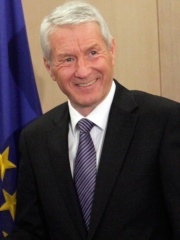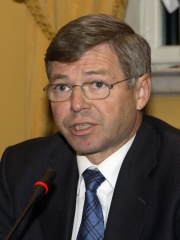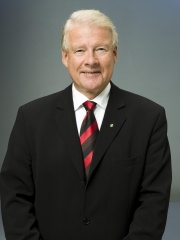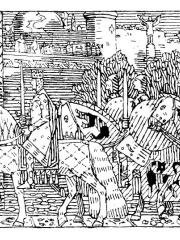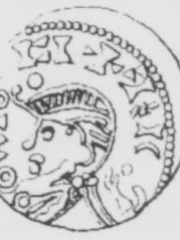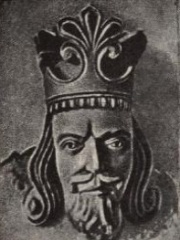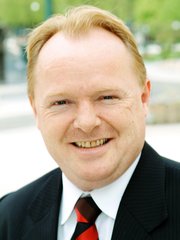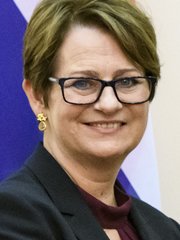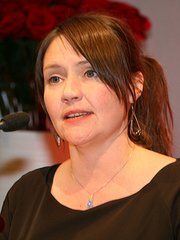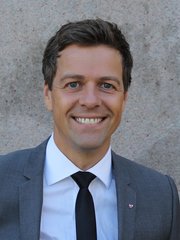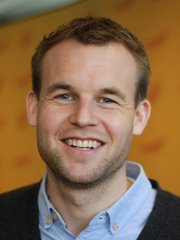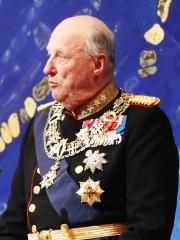
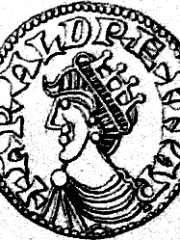
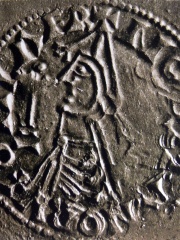
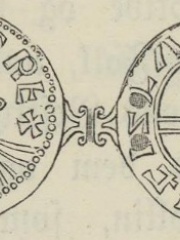
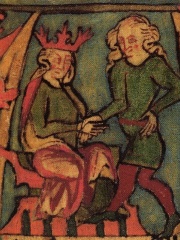
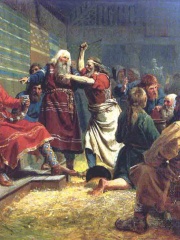
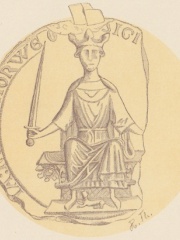
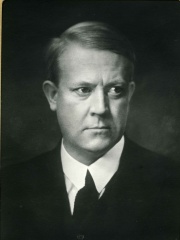
The Most Famous
POLITICIANS from Norway
This page contains a list of the greatest Norwegian Politicians. The pantheon dataset contains 19,576 Politicians, 136 of which were born in Norway. This makes Norway the birth place of the 26th most number of Politicians behind Netherlands, and Belgium.
Top 10
The following people are considered by Pantheon to be the top 10 most legendary Norwegian Politicians of all time. This list of famous Norwegian Politicians is sorted by HPI (Historical Popularity Index), a metric that aggregates information on a biography's online popularity. Visit the rankings page to view the entire list of Norwegian Politicians.

1. Harald V of Norway (b. 1937)
With an HPI of 85.45, Harald V of Norway is the most famous Norwegian Politician. His biography has been translated into 90 different languages on wikipedia.
Harald V (Norwegian: Harald den femte, Norwegian pronunciation: [ˈhɑ̂rːɑɫ dɛn ˈfɛ̂mtə]; born 21 February 1937) is King of Norway, reigning since 1991. A member of the House of Glücksburg, Harald was the third child and only son of King Olav V of Norway and Princess Märtha of Sweden. He was second in the line of succession at the time of his birth, behind his father. In 1940, as a result of the German occupation during World War II, the royal family went into exile. Harald spent part of his childhood in Sweden and the United States. He returned to Norway in 1945, and subsequently studied for periods at the University of Oslo, the Norwegian Military Academy, and Balliol College, Oxford. A keen sportsman, Harald represented Norway in sailing at the 1964, 1968, and 1972 Olympic Games, and later became patron of World Sailing. Following the death of his paternal grandfather King Haakon VII in 1957, Harald became crown prince as his father became King Olav V. He married Sonja Haraldsen in 1968; their relationship having initially been controversial due to her status as a commoner. They have two children, their elder child Märtha Louise and their younger child Haakon, who is heir apparent due to the male-preference primogeniture used in Norway at the time of his birth. In 1990, when his father's health started declining, Harald became regent and thus took most of the powers of the monarchy while Olav remained the de facto monarch. Following his father's death in 1991, Harald officially ascended to the throne. He was the first Norwegian monarch born in Norway since Olav IV in 1367, a span of nearly 600 years. Key events in Harald's reign were the start of the 21st century and third millennium and the 2011 Norway attacks. During his reign, he has also suffered from health problems, with his son, Crown Prince Haakon, acting as regent four times between 2003 and 2024. Since 2024, Harald has been Norway's oldest-reigning monarch, surpassing his father; since the death of Elizabeth II in 2022, he is also the oldest-reigning monarch in Europe.

2. Harald Hardrada (1015 - 1066)
With an HPI of 84.83, Harald Hardrada is the 2nd most famous Norwegian Politician. His biography has been translated into 56 different languages.
Harald Sigurdsson (Old Norse: Haraldr Sigurðarson; c. 1015 – 25 September 1066), also known as Harald III of Norway and given the epithet Hardrada in the sagas, was King of Norway from 1046 to 1066. He unsuccessfully claimed the Danish throne until 1064 and the English throne in 1066. Before becoming king, Harald spent 15 years in exile as a mercenary and military commander in Kievan Rus' and chief of the Varangian Guard in the Byzantine Empire. In his chronicle, Adam of Bremen called him the "Thunderbolt of the North". In 1030, the fifteen-year-old Harald fought in the Battle of Stiklestad alongside his half-brother Olaf Haraldsson. Olaf sought to reclaim the Norwegian throne, which he had lost to Danish king Cnut two years previously. Olaf and Harald were defeated by forces loyal to Cnut, and Harald was forced into exile to Kievan Rus'. Thereafter, he was in the army of Grand Prince Yaroslav the Wise, becoming captain, until he moved on to Constantinople with his companions around 1034. In Constantinople, he rose quickly to become the commander of the Byzantine Varangian Guard, seeing action on the Mediterranean Sea, in Asia Minor, Sicily, possibly in the Holy Land, Bulgaria and in Constantinople itself, where he became involved in the imperial dynastic disputes. Harald amassed wealth whilst in the Byzantine Empire, which he shipped to Yaroslav in Kievan Rus' for safekeeping. In 1042, he left the Byzantine Empire, returning to Kievan Rus' to prepare to reclaim the Norwegian throne. In his absence the Norwegian throne had been restored from the Danes to Olaf's illegitimate son Magnus the Good. In 1046, Harald joined forces with Magnus's rival in Denmark, the pretender Sweyn II of Denmark, raiding the Danish coast. Magnus, unwilling to fight his uncle, agreed to share the kingship with Harald, since Harald in turn would share his wealth with him. The co-rule ended abruptly the next year as Magnus died: Harald became the sole ruler of Norway. Domestically, Harald crushed opposition, and outlined the unification of Norway. Harald's reign was one of relative peace and stability, and he instituted a coin economy and foreign trade. Seeking to restore Cnut's "North Sea Empire", Harald claimed the Danish throne, and spent nearly every year until 1064 raiding the Danish coast and fighting his former ally, Sweyn. Although the campaigns were successful, he was never able to conquer Denmark. Not long after Harald had renounced his claim to Denmark, the former Earl of Northumbria, Tostig Godwinson, brother of English king Harold Godwinson, pledged his allegiance to Harald, inviting him to claim the English throne. Harald assented, invading northern England with 10,000 troops and 300 longships in September 1066, defeating the English regional forces of Northumbria and Mercia in the Battle of Fulford near York on 20 September. Harald was defeated and killed in a surprise attack by Harold Godwinson's forces in the Battle of Stamford Bridge on 25 September, which wiped out his army. Historians often consider Harald's death the end of the Viking Age.

3. Olaf II of Norway (993 - 1030)
With an HPI of 81.52, Olaf II of Norway is the 3rd most famous Norwegian Politician. His biography has been translated into 47 different languages.
Saint Olaf (c. 995 – 29 July 1030), also called Olaf the Holy, Olaf II, Olaf Haraldsson, and Olaf the Stout or "Large", was King of Norway from 1015 to 1028. Son of Harald Grenske, a petty king in Vestfold, Norway, he was posthumously given the title Rex Perpetuus Norvegiae (English: Eternal/Perpetual King of Norway) and canonised at Nidaros (Trondheim) by Bishop Grimketel, one year after his death in the Battle of Stiklestad on 29 July 1030. His remains were enshrined in Nidaros Cathedral, built over his burial site. His sainthood encouraged the widespread adoption of Christianity by Scandinavia's Vikings/Norsemen. Pope Alexander III confirmed Olaf's local canonisation in 1164, making him a recognised saint of the Catholic Church, and Olaf started to be known as Rex Perpetuus Norvegiae – eternal king of Norway. Following the Reformation, he was a commemorated historical figure among some members of the Lutheran and Anglican Communions. The saga of Olav Haraldsson and the legend of Olaf the Saint became central to a national identity. Especially during the period of romantic nationalism, Olaf was a symbol of Norwegian independence and pride. Saint Olaf is symbolised by the axe in Norway's coat of arms and Olsok (29 July) is still his day of celebration. Many Christian institutions with Scandinavian links as well as Norway's Order of St. Olav are named after him.

4. Magnus the Good (1024 - 1047)
With an HPI of 79.92, Magnus the Good is the 4th most famous Norwegian Politician. His biography has been translated into 42 different languages.
Magnus Olafsson (Old Norse: Magnús Óláfsson; Norwegian and Danish: Magnus Olavsson; c. 1024 – 25 October 1047), better known as Magnus the Good (Old Norse: Magnús góði; Norwegian and Danish: Magnus den gode), was King of Norway from 1035 and King of Denmark from 1042 until his death in 1047. Magnus was an illegitimate son of Saint Olaf, and fled with his mother Alfhild when his father was dethroned in 1028. He returned to Norway in 1035 and was crowned king at the age of 11. In 1042, he was also crowned king of Denmark. Magnus ruled the two countries until 1047, when he died under unclear circumstances. After his death, his kingdom was split between Harald Hardrada in Norway and Sweyn Estridsson in Denmark.
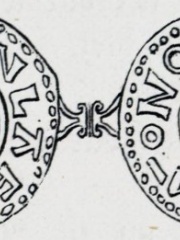
5. Olaf Tryggvason (963 - 1000)
With an HPI of 78.80, Olaf Tryggvason is the 5th most famous Norwegian Politician. His biography has been translated into 44 different languages.
Olaf Tryggvason (960s – 9 September 1000) was King of Norway from 995 to 1000. He was the son of Tryggvi Olafsson, king of Viken (Vingulmark, and Rånrike), and, according to later sagas, the great-grandson of Harald Fairhair, first King of Norway. He is numbered as Olaf I. Olaf was important in the conversion of the Norse to Christianity, but he did so forcibly within his own kingdom. He is said to have built the first Christian church in Norway in 995, and to have founded the city of Trondheim in 997. A statue dedicated to him is located in the city's central plaza. Historical information on Olaf is sparse. He is mentioned in some contemporary English sources, and some skaldic poems. The oldest narrative source mentioning him briefly is Adam of Bremen's Gesta Hammaburgensis ecclesiae pontificum of circa 1070. In the 1190s, two Latin versions of "Óláfs saga Tryggvasonar" were written in Iceland, by Oddr Snorrason and Gunnlaugr Leifsson – these are now lost, but are thought to form the basis of later Norse versions. Snorri Sturluson gives an extensive account of Olaf in the Heimskringla saga of circa 1230, using Oddr Snorrason's saga as his primary source. Modern historians do not assume that these late sources are accurate, and their credibility is debated. The most detailed account is named Óláfs saga Tryggvasonar en mesta ("Greatest Saga of Óláfr Tryggvason") and is recorded in the Flateyjarbók, and in the early 15th-century Bergsbók.

6. Harald Fairhair (850 - 933)
With an HPI of 77.69, Harald Fairhair is the 6th most famous Norwegian Politician. His biography has been translated into 49 different languages.
Harald Fairhair (Old Norse: Haraldr Hárfagri; c. 850 – c. 932) was a Norwegian king. According to traditions current in Norway and Iceland in the eleventh and twelfth centuries, he reigned from c. 872 to 930 and was the first King of Norway. Supposedly, two of his sons, Eric Bloodaxe and Haakon the Good, succeeded Harald to become kings after his death. Much of Harald's biography is uncertain. A couple of praise poems by his court poet Þorbjörn Hornklofi survive in fragments, but the extant accounts of his life come from sagas set down in writing around three centuries after his lifetime. His life is described in several of the Kings' sagas, none of them older than the twelfth century. Their accounts of Harald and his life differ on many points, but it is clear that in the twelfth and thirteenth centuries Harald was regarded as having unified Norway into one kingdom. Since the nineteenth century, when Norway was in a personal union with Sweden, Harald has become a national icon of Norway and a symbol of independence. Though the king's sagas and medieval accounts have been critically scrutinised during the twentieth and early twenty-first centuries, Harald maintains a reputation as the father of the Norwegian nation. At the turn of the 21st century, a few historians have tried to argue that Harald Fairhair did not exist as a historical figure.

7. Haakon the Good (918 - 961)
With an HPI of 77.52, Haakon the Good is the 7th most famous Norwegian Politician. His biography has been translated into 40 different languages.
Haakon Haraldsson (c. 920–961), also Haakon the Good (Old Norse: Hákon góði, Norwegian: Håkon den gode) and Haakon Adalsteinfostre (Old Norse: Hákon Aðalsteinsfóstri, Norwegian: Håkon Adalsteinsfostre), was the king of Norway from 934 to 961. He was noted for his attempts to introduce Christianity into Norway.

8. Haakon IV of Norway (1204 - 1263)
With an HPI of 76.99, Haakon IV of Norway is the 8th most famous Norwegian Politician. His biography has been translated into 41 different languages.
Haakon IV Haakonsson (c. March/April 1204 – 16 December 1263; Old Norse: Hákon Hákonarson [ˈhɑːˌkon ˈhɑːˌkonɑrˌson]; Norwegian: Håkon Håkonsson), sometimes called Haakon the Old in contrast to his namesake son, was King of Norway from 1217 to 1263. His reign lasted for 46 years, longer than any Norwegian king since Harald Fairhair. Haakon was born into the troubled civil war era in Norway, but his reign eventually managed to put an end to the internal conflicts. At the start of his reign, during his minority, Earl Skule Bårdsson served as regent. As a king of the Birkebeiner faction, Haakon defeated the uprising of the final Bagler royal pretender, Sigurd Ribbung, in 1227. He put a definitive end to the civil war era when he had Skule Bårdsson killed in 1240, a year after Skule had himself proclaimed king in opposition to Haakon. Haakon thereafter formally appointed his own eldest son, Haakon the Young, as his co-regent. Under Haakon's rule, medieval Norway is considered to have reached its zenith or golden age. His reputation and formidable naval fleet allowed him to maintain friendships with both the pope and the Holy Roman Emperor, despite their conflict. He was at different points offered the imperial crown by the pope, the High Kingship of Ireland by a delegation of Irish kings, and the command of the French crusader fleet by the French king. He amplified the influence of European culture in Norway by importing and translating contemporary European literature into Old Norse, and by constructing monumental European-style stone buildings. In conjunction with this he employed an active and aggressive foreign policy, and at the end of his rule added Iceland and the Norse Greenland community to his kingdom, leaving the Norwegian realm at its territorial height. Although he for the moment managed to secure Norwegian control of the islands off the northern and western shores of Scotland, plus the Isle of Man, he fell ill and died when wintering in Orkney following some military engagements with the expanding Kingdom of Scotland. He was succeeded by his second son, Magnus VI.

9. Vidkun Quisling (1887 - 1945)
With an HPI of 76.38, Vidkun Quisling is the 9th most famous Norwegian Politician. His biography has been translated into 64 different languages.
Vidkun Abraham Lauritz Jonssøn Quisling (; Norwegian: [ˈʋɪ̂dkʉn ˈkʋɪ̂slɪŋ] ; 18 July 1887 – 24 October 1945) was a Norwegian military officer, politician and Nazi collaborator who headed the government of Norway during the country's occupation by Nazi Germany during World War II. He first came to international prominence as a close collaborator of the explorer Fridtjof Nansen and through organising humanitarian relief during the Russian famine of 1921 in Povolzhye. He was posted as a Norwegian diplomat to the Soviet Union and for some time also managed British diplomatic affairs there. He returned to Norway in 1929 and served as minister of defence in the agrarian governments of Peder Kolstad (1931–1932) and Jens Hundseid (1932–1933). In 1933, Quisling founded the fascist Nasjonal Samling (National Gathering). Although he gained some popularity after his attacks on the political left, his party failed to win any seats in the Storting, and by 1940, it was still little more than peripheral. On 9 April 1940, with the German invasion of Norway in progress, he attempted to seize power in the world's first radio-broadcast coup d'état but failed since the Germans sought to convince the recognised Norwegian government to legitimize the German occupation, as had been done in Denmark during the simultaneous invasion there, instead of recognizing Quisling. On 1 February 1942, he formed a second government, approved by the Germans, and served as minister president. He headed the Norwegian state administration jointly with the German civilian administrator, Josef Terboven. His pro-Nazi puppet government, known as the Quisling regime, was dominated by ministers from Nasjonal Samling. The collaborationist government participated in Germany's war efforts and deported Jews out of the country to concentration camps in occupied Poland, where most were killed. Quisling was put on trial during the legal purge in Norway after World War II. He was found guilty of charges including embezzlement, murder and high treason against the Norwegian state, and was sentenced to death, a sentence which subsequently garnered some criticism due to its questionable legality; besides by the occupation authority, with Quisling's support (including retroactive verdicts), no death sentence had been executed since 1876, and capital punishment had been abolished upon independence in 1905. Quisling was shortly after executed by firing squad at Akershus Fortress, Oslo, on 24 October 1945. Since his death, he has come to be seen as one of European history's foremost traitors due to his collaboration with Nazi Germany. The term Quisling has become a word for "collaborator" or "traitor" in English and Scandinavian languages.
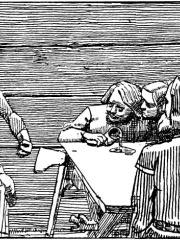
10. Harald Greycloak (935 - 970)
With an HPI of 76.27, Harald Greycloak is the 10th most famous Norwegian Politician. His biography has been translated into 37 different languages.
Harald Greycloak (Old Norse: Haraldr gráfeldr, lit. "Harald Grey-hide"; Norwegian: Harald Gråfell; Danish: Harald Gråfeld; c. 935 – c. 970) was a king of Norway from the Fairhair dynasty. Harald acquired his nickname "Gray-hide" after an encounter with the crew of an Icelandic merchant ship which carried a large load of vararfeldir, a type of faux fur made from sheep's wool. The Icelanders were having trouble selling their faux furs so when the king asked them if they would make a present to him of one of the furs, which happened to be grey, the sailors did not hesitate and the king immediately used it as a cloak. This set an instant fashion trend and before long the Icelanders had sold their entire load of previously unsalable furs to the king's men and the locals. Harald was ever after known as Harald "Gray-hide". Harald was the son of Eric Bloodaxe and a grandson of Harald Fairhair. His mother was Gunnhild, the sister of King Harald Bluetooth. After his father's death in 954, Harald and his brothers allied with their uncle, King Harald Bluetooth, against their half-uncle King Haakon the Good. They fought several battles against King Haakon including the Battle of Rastarkalv near the island of Frei in 955 and the Battle of Fitjar in 961. After King Haakon's death at Fitjar, Harald and his brothers became kings of Norway, but they had little authority outside Western Norway. Harald, by being the oldest, was the most powerful of the brothers. In 961, their uncle King Harald Bluetooth of Denmark traveled to Norway and declared Harald Greycloak to be his vassal king in Norway. Harald moved to strengthen his rule by killing the local rulers including Sigurd Haakonsson, Tryggve Olafsson and Gudrød Bjørnsson. Harald Greycloak thus took power over the country up to and including Hålogaland. Harald established control over the trade route along the Norwegian coast. He also undertook a Viking expedition to Bjarmaland, today the area of Arkhangelsk in northern Russia. Harald soon became less dependent on support from Harald Bluetooth. In 970, he was tricked into coming to Denmark and killed in Hals in the Limfjord in a plot planned by Sigurd Haakonsson's son Haakon, who had become an ally of Harald Bluetooth. Haakon Sigurdsson had become the jarl of Lade after his own father was killed by Harald Greycloak's men in the autumn of 962. The surviving brothers of Harald Greyhide fled the country after his death. With the death of Harald Greycloak, King Harald Bluetooth won back power over Norway and he supported Haakon Sigurdsson as his vassal king.
People
Pantheon has 136 people classified as Norwegian politicians born between 810 and 1993. Of these 136, 53 (38.97%) of them are still alive today. The most famous living Norwegian politicians include Harald V of Norway, Gro Harlem Brundtland, and Princess Astrid, Mrs. Ferner. The most famous deceased Norwegian politicians include Harald Hardrada, Olaf II of Norway, and Magnus the Good. As of April 2024, 10 new Norwegian politicians have been added to Pantheon including Per Sandberg, Tone Wilhelmsen Trøen, and Eva Kristin Hansen.
Living Norwegian Politicians
Go to all RankingsHarald V of Norway
1937 - Present
HPI: 85.45
Gro Harlem Brundtland
1939 - Present
HPI: 75.32
Princess Astrid, Mrs. Ferner
1932 - Present
HPI: 72.42
Jens Stoltenberg
1959 - Present
HPI: 72.38
Princess Märtha Louise of Norway
1971 - Present
HPI: 64.22
Jonas Gahr Støre
1960 - Present
HPI: 63.96
Erna Solberg
1961 - Present
HPI: 63.76
Thorbjørn Jagland
1950 - Present
HPI: 62.08
Kjell Magne Bondevik
1947 - Present
HPI: 62.03
Eva Joly
1943 - Present
HPI: 58.74
Magne Thomassen
1941 - Present
HPI: 54.78
Carl I. Hagen
1944 - Present
HPI: 52.08
Deceased Norwegian Politicians
Go to all RankingsHarald Hardrada
1015 - 1066
HPI: 84.83
Olaf II of Norway
993 - 1030
HPI: 81.52
Magnus the Good
1024 - 1047
HPI: 79.92
Olaf Tryggvason
963 - 1000
HPI: 78.80
Harald Fairhair
850 - 933
HPI: 77.69
Haakon the Good
918 - 961
HPI: 77.52
Haakon IV of Norway
1204 - 1263
HPI: 76.99
Vidkun Quisling
1887 - 1945
HPI: 76.38
Harald Greycloak
935 - 970
HPI: 76.27
Sigurd the Crusader
1090 - 1130
HPI: 76.23
Magnus Barefoot
1073 - 1103
HPI: 75.87
Magnus VI of Norway
1238 - 1280
HPI: 75.58
Newly Added Norwegian Politicians (2025)
Go to all RankingsPer Sandberg
1960 - Present
HPI: 44.98
Tone Wilhelmsen Trøen
1966 - Present
HPI: 42.42
Eva Kristin Hansen
1973 - Present
HPI: 39.74
Terese Pedersen
1980 - Present
HPI: 36.38
Knut Arild Hareide
1972 - Present
HPI: 36.36
Iselin Nybø
1981 - Present
HPI: 35.81
Kjersti Buaas
1982 - Present
HPI: 34.91
Linda Hofstad Helleland
1977 - Present
HPI: 33.88
Simen Spieler Nilsen
1993 - Present
HPI: 33.41
Kjell Ingolf Ropstad
1985 - Present
HPI: 32.32
Overlapping Lives
Which Politicians were alive at the same time? This visualization shows the lifespans of the 25 most globally memorable Politicians since 1700.

